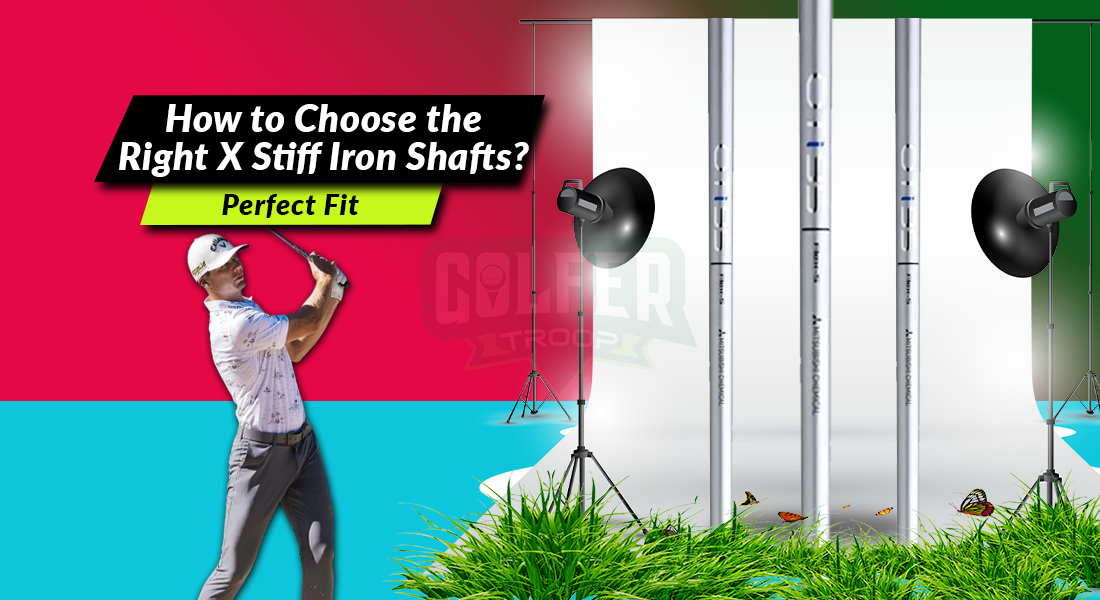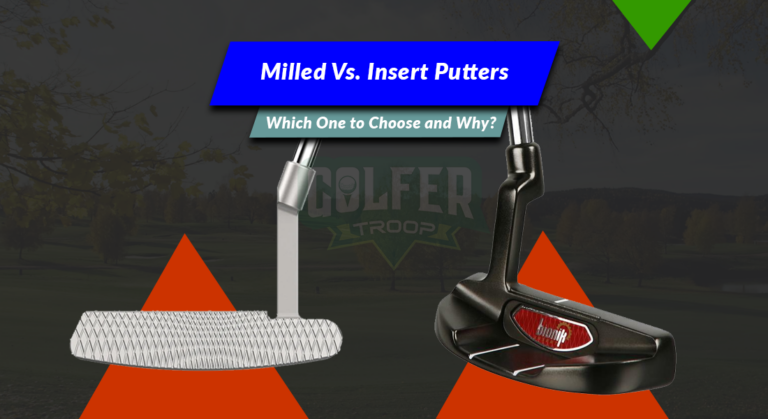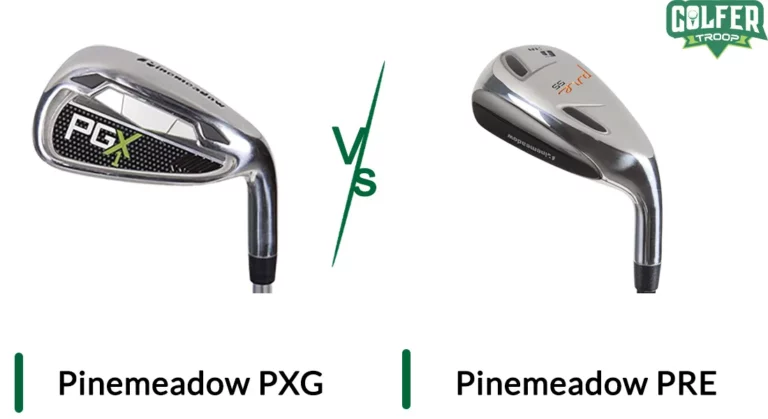How to Choose the Right X Stiff Iron Shafts? [Perfect Fit]
Shaft flex has always been a matter of concern to pro and amateur golfers, especially players who get confused in terms of selecting the X stiff iron shafts. Because their accuracy lures them to buy it, but their stiffness holds the slow swingers back.
Choosing the right stiffer shaft not only depends on the swing mechanism but also on the profile of the shafts. It is better to go for lightweight, steel-made, and tip–to–bottom stiff shafts for the faster swingers.
Based on your personal preferences, different varieties of X-stiffs are ideal. And to get a better understanding of them, sit tight, and let’s get straight into it!

Characteristics of the X Stiff Iron Shafts
X–stiff are different inbuilt quality than the regular flex shafts. So, their characteristics that play a role in the performance are several in terms of spin, speed, and many more as shown in the chart:
| Criteria | X Stiff Characteristics |
| Spin rate | Lowest spin |
| Playing angle | Optimal to lower angle shots |
| Swing speed | 110-120 mph |
| Material | steel, graphite, steel-fiber |
| Weight | Mainly lightweight within 60 grams |

Benefits of Using X Stiff Iron Shafts?
As the flexible shafts for your irons provide more power for longer shots, most players prefer these shafts. But the flexibility reduces the accuracy of the shot, unlike the X–stiffs. And the stiffer shafts have more such benefits that we’d like to share right here:
More Control
X-stiff shafts help golfers to hit the ball in a straight line instead of striking a shot that goes right or left from the target. And that’s preferable for the one with higher swing speeds than 90 miles per hour.
During tours or championships, pro players can use a rangefinder only to measure the distance.
You aren’t allowed to get other data from the device to plan an in-line shot. In such situations to set your position and grip for better control, you have to rely on stiffer shafts.
Less Distance Loss
Players that use an upright swing plane mechanism with a regular stiff can strike the ball too high. Thereby, the ball lands too close to the player than the hole.
In order to prevent this distance loss, we guess there is no better alternative to stiffer shafts.
The built quality of the X model promotes control to hit lower or optimal angles. Feel free to watch it to learn how it provides better control:
Better Clubhead Movement
Are you a fast swinger with more than 92 mph on the downswing? Well, the clubhead will move from side to side due to a flexible shaft. Thereby, club fitters construct X-stiff shafted iron to match your speed.
Usually, stiffer irons don’t let the clubhead wobble during a downswing. And you get to hit an approach shot that doesn’t deviate from the pointing direction.
Low Spin
It’s a real struggle to get the lowest spin rpm of the ball with a stiff shaft. As a result, high spin increases distance loss and curvature to the ball flight.
X–stiff shafted irons limit the spin so that the ball can follow a controlled flight. And such spin is essential for beginners and high-handicaps.
Ideal for Fast Swing Tempos and Low Dispersion
Fast-swing tempo or short backswing players often lose distance while hitting the ball with a flexible iron.
So, the Golf Teachers federation recommends using a stiffer iron, controlling the iron to get a better result with faster tempos. This is how the x–stiff impacts the tempo:
Also, without a stiffer iron, the dispersion rate can be higher than average. As a result, the ball doesn’t stay on track.
For lower and good dispersion, club fitters recommend using stiffer and least flexible shafts.
Who Should Use X-stiff Iron Shafts?
Aged golfers tend to lose distance accuracy with time. And a stiffer shaft can help them control their speed and spin to hit the shot as close to the hole as possible.
Also, players with more than 90 miles per hour swing speed should definitely go for stiffer shafts for irons.
Otherwise, the flexibility of the regular shaft will require you to slow down your overall speed. And the limitation is speed can affect the ball’s flight!
How to Choose the Right X Stiff Iron Shafts?
The stiffness of the iron shafts isn’t the only factor to consider while buying such shafts. Rather, there are several factors that make an ideal X–stiff, and let’s pay attention to them:
Considering the Shaft Weight
X–stiffs come in a variety of different weights. Make sure to choose a shaft that stays aligned with your swing mechanism and tempo. The general rule of thumb is faster swing speeds require lightweight shafts for irons.
For example, if you have more than 90 mph speed, consider buying a stiffer shift that weighs not more than 60 grams. It allows the fast swingers to control the club head in a better way.
Or else, with a heavy x–stiff shaft you will not be able to produce faster swings for an accurate strike.
Material
The most common materials for X-stiff shafts for iron clubs are steel and graphite. But now graphite-like steel fiber elements are also on the rise to make x-stiffs. So, it gets confusing to choose!
However, most professional golfers prefer using the steel-made shaft as they can provide more control to the players with a high club speed (106–156 mph)
But if you lack the speed, go for a graphite X–stiff. This will help you to cut down the additional vibration, unlike the steel-made stiffer shafts.
If you don’t want to switch your stiff model early, consider buying a steel-made shaft, even if you are a beginner!
Because amateur golfers gradually increase the club speed rate and need to switch to the steel–stiff anyway. That will cost you bucks within a short span of practice.
Go through the Shaft Profile
X–stiff shafts are differently stiff in different parts. For example, the stiffness differs in the tip, middle, and butt of the shaft.
And such varieties can affect your performance. So, go through the EI profiles, where you can find the different stiffness ratios of the X–stiff model you prefer. Here is what a basic profile looks like:
Frequently Asked Questions (F.A.Q’s)
As stiff and X-stiff shafts both have their share of advantages, it is troublesome to choose between them. But to lean towards the X–stiff scan, these most searched questions with answers are as follows:
Is x–stiff better for beginner players?
Generally, fitters don’t recommend stiffer shafts to beginners. But it depends on the swing speed and flight they practice with. If an amateur player tends to pick up on swing rate and prefers straight shot practices, they can use stiffer shafts.
Is x–stiff shaft costly?
Due to the build quality and stiffness of the X-stiffs, they’re a bit costlier than the regular shafts. Different manufacturers sell them at different rates. So, to confirm the price, you need to visit their websites.
How long-lasting is an x–stiff shaft?
As the stiffer shafts are harder, they tend to withstand harsh strikes. And their steel material keeps them safe from extreme weather and rust. Stiffer models take less wear and tear from frequent use. So, they are more durable than flexible shafts.
Conclusion
Just because X stiff iron shafts are the least flexible, doesn’t mean that they are not beginner-friendly!
In fact, beginners who prefer the lowest spin on the ball are likely to be benefitted from these shafts.
Having said that, they need constant practice with it in order to learn to handle it better. Generally, the pro golfers on tours prefer stiffer shafts for better accuracy and less distance loss.
Before you choose an X-stiff flex shaft, we’d prefer contacting a club fitter to know more about its weight.
And they will provide you with guidelines based on which you can match a stiffer shaft close to your needs.
Read More:
How To Choose The Right X Stiff Iron Shafts? [Perfect Fit]
Changing Shaft On Adjustable Driver – A To Z Explanation
Mitsubishi Tensei AV Blue Vs Hzrdus Smoke Shaft Comparison
True Temper Elevate 95 Vs 105: Which Golf Shaft to Choose?
Meet Jalal, a passionate golf writer and the driving force behind Golfertroop.com, your go-to destination for all things golfing! Whether you’re a seasoned golfing veteran or a beginner taking your first swing, Jalal is here to assist you in making the most out of your golfing experience.






